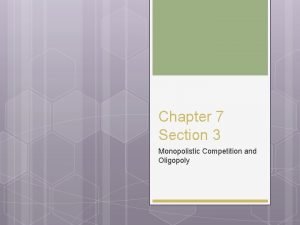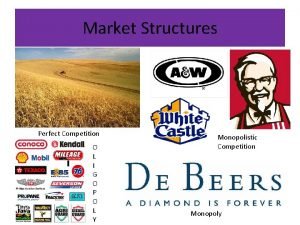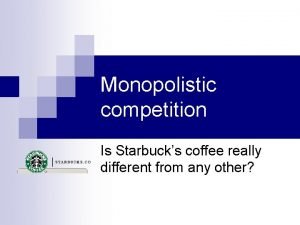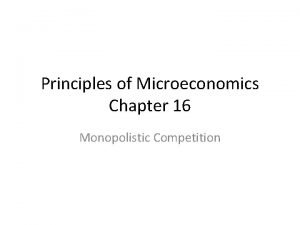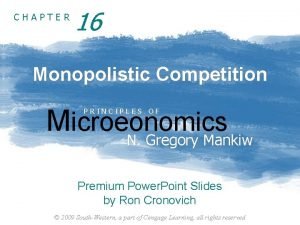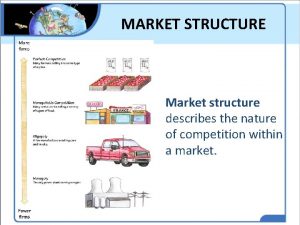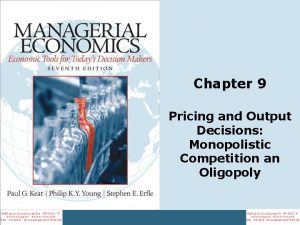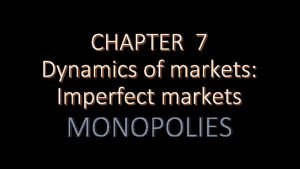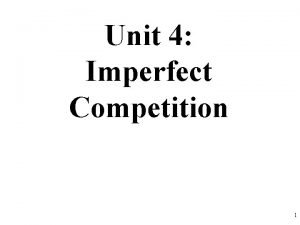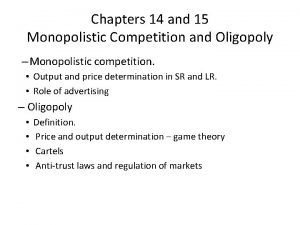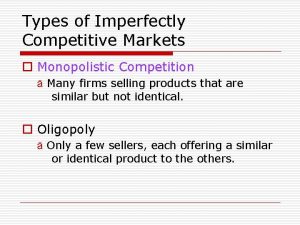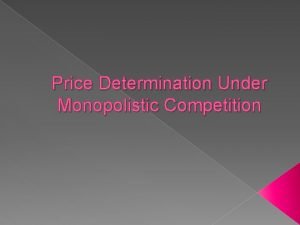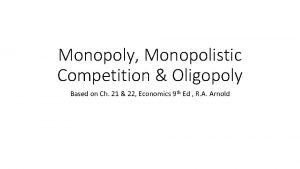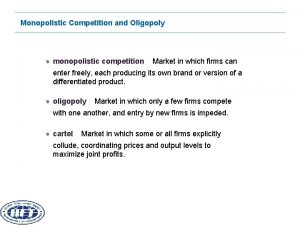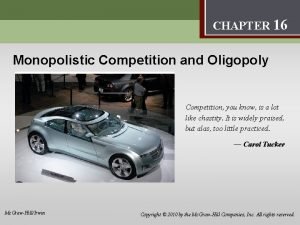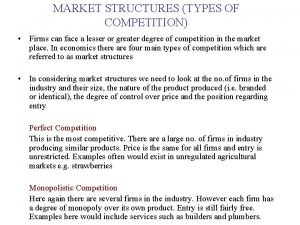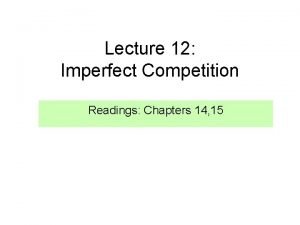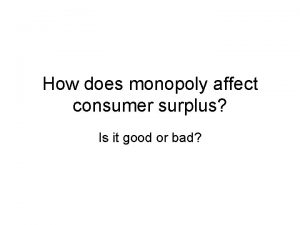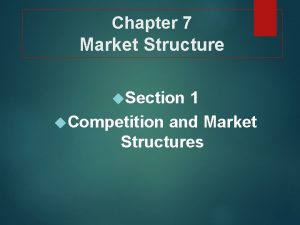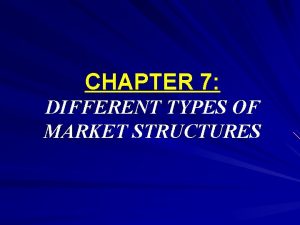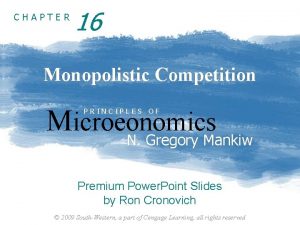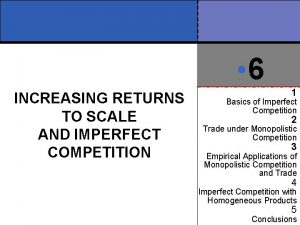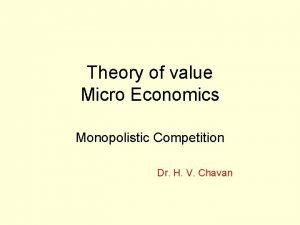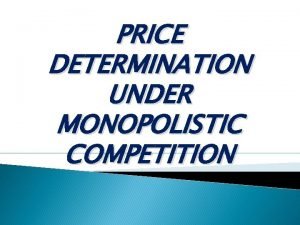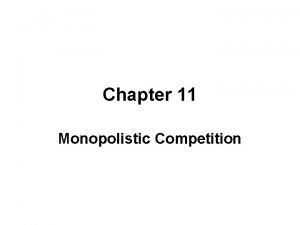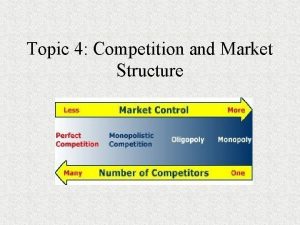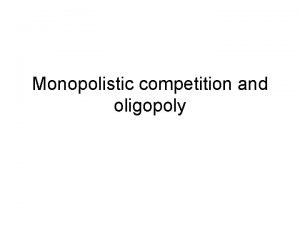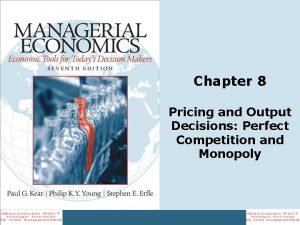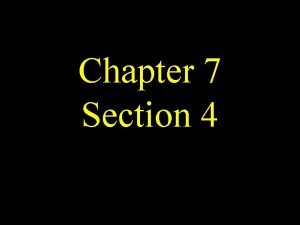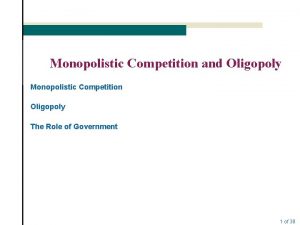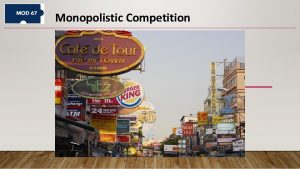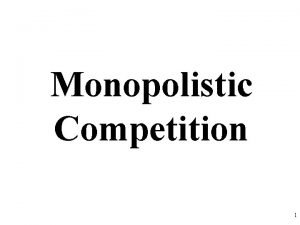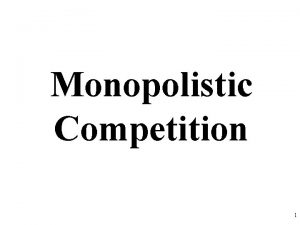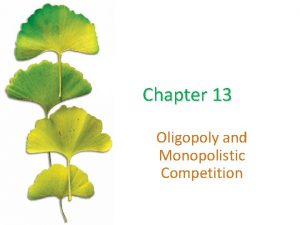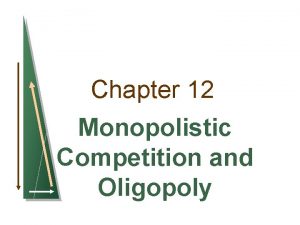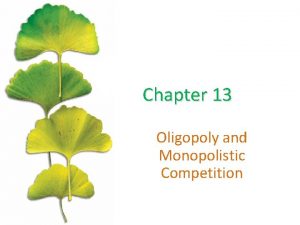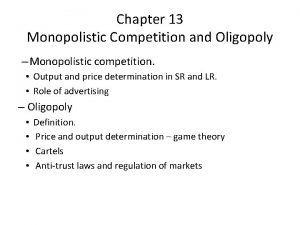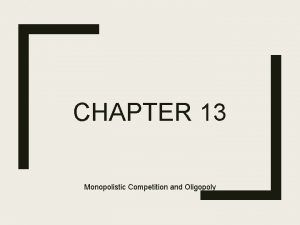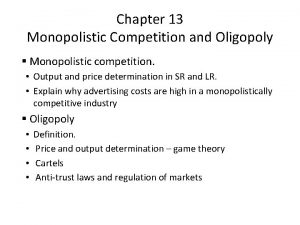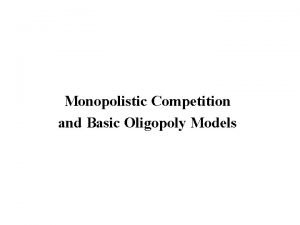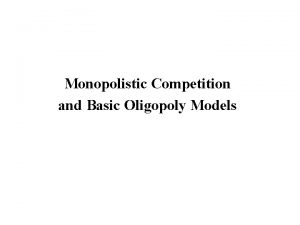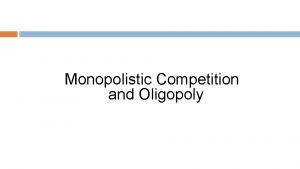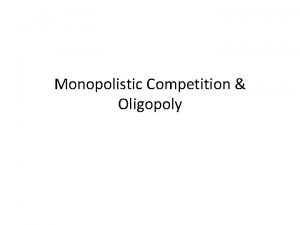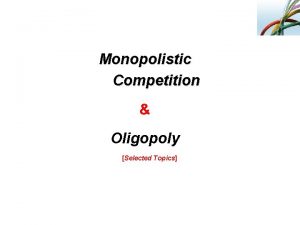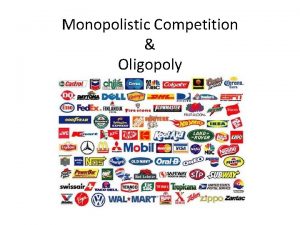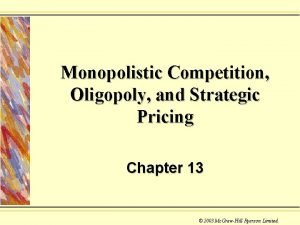Chapter 12 Monopolistic Competition Oligopoly and Strategic Pricing







































- Slides: 39

Chapter 12: Monopolistic Competition, Oligopoly, and Strategic Pricing Prepared by: Kevin Richter, Douglas College Charlene Richter, British Columbia Institute of Technology © 2006 Mc. Graw-Hill Ryerson Limited. All rights reserved. 1

Chapter Objectives n 1. Describe two methods of determining market structure. n 2. List four distinguishing characteristics of monopolistic competition. n 3 a. Demonstrate graphically the equilibrium of a monopolistic competitor. 3 b. Discuss how differentiated products relate to the excess capacity theorem. © 2006 Mc. Graw-Hill Ryerson Limited. All rights reserved. 2

Chapter Objectives n 4. State the central element of oligopoly. n 5 a. Explain sticky prices using the kinked demand model of oligopoly. 5 b. Explain why decisions in the cartel model depend on market share and decisions in the contestable market model depend on barriers to entry. © 2006 Mc. Graw-Hill Ryerson Limited. All rights reserved. 3

Chapter Objectives n 6. Illustrate a strategic decision facing a duopolist using the prisoner’s dilemma payoff matrix. © 2006 Mc. Graw-Hill Ryerson Limited. All rights reserved. 4

Introduction n Market structure involves the number of firms in the market and the barriers to entry. © 2006 Mc. Graw-Hill Ryerson Limited. All rights reserved. 5

Defining a Market n Defining a market has problems: n What is an industry and what is its geographic market? q n Local, national, or international? What products are to be included in the definition of an industry? © 2006 Mc. Graw-Hill Ryerson Limited. All rights reserved. 6

Classifying Industries n One of the ways in which economists classify markets is by cross-price elasticities. n Cross-price elasticity measures the responsiveness of the change in demand for a good to change in the price of a related good. © 2006 Mc. Graw-Hill Ryerson Limited. All rights reserved. 7

Classifying Industries n Industries are classified by government using the North American Industry Classification System (NAICS). n The North American Industry Classification System (NAICS) is a classification system of industries adopted by Canada, Mexico, and the U. S. in 1997. © 2006 Mc. Graw-Hill Ryerson Limited. All rights reserved. 8

Concentration Ratio n The concentration ratio is the percentage of industry sales by the top few firms. © 2006 Mc. Graw-Hill Ryerson Limited. All rights reserved. 9

Herfindahl Index n The Herfindahl index is an index of market concentration calculated by adding the squared values of the individual market shares of all the firms in the industry. © 2006 Mc. Graw-Hill Ryerson Limited. All rights reserved. 10

Monopolistic Competition n The four distinguishing characteristics of monopolistic competition are: q Many sellers. q Differentiated products. q Multiple dimensions of competition. q Easy entry of new firms in the long run. © 2006 Mc. Graw-Hill Ryerson Limited. All rights reserved. 11

Output, Price, and Profit n A monopolistically competitive firm produces in the same manner as a monopolist—to maximize profit, it chooses the quantity where MC = MR. n Having determined output, the firm will charge what consumers are willing to pay (determined by the demand curve). © 2006 Mc. Graw-Hill Ryerson Limited. All rights reserved. 12

Output, Price, and Profit n If price exceeds ATC, the firm will earn positive economic profits. n These profits attract entry. n Some customers of the existing firms switch to become customers of the new firm. © 2006 Mc. Graw-Hill Ryerson Limited. All rights reserved. 13

Output, Price, and Profit n Entry causes the existing firm’s demand curve to shift left (decrease) as they lose customers. n Competition, therefore, implies zero economic profit in the long run. © 2006 Mc. Graw-Hill Ryerson Limited. All rights reserved. 14

Output, Price, and Profit n At the long-run equilibrium, ATC equals price and economic profits are zero. n This occurs at the point of tangency of the ATC and demand curve at the output chosen by the firm. © 2006 Mc. Graw-Hill Ryerson Limited. All rights reserved. 15

Monopolistic Competition: Short Run Price P 1 C 1 MC ATC 1 MR 0 Q 1 © 2006 Mc. Graw-Hill Ryerson Limited. All rights reserved. D 1 Quantity 16

Monopolistic Competition: Short Run Price MC ATC 2 ATC 1 P 2 C 1 0 Q 2 Q 1 MR 2 © 2006 Mc. Graw-Hill Ryerson Limited. All rights reserved. D 2 D 1 Quantity 17

Monopolistic Competition: Long Run Price MC P 1 P 2 P 3 =C 3 C 2 C 1 ATC 3 ATC 2 MR 2 0 Q 3 MR 3 © 2006 Mc. Graw-Hill Ryerson Limited. All rights reserved. D 2 D 3 Quantity 18

Comparing Monopolistic Competition and Perfect Competition n Both the monopolistic competitor and the perfect competitor make zero economic profit in the long run. n A monopolistic competitor produces less than a perfect competitor. © 2006 Mc. Graw-Hill Ryerson Limited. All rights reserved. 19

Comparing Monopolistic Competition and Perfect Competition Price MC ATC D PC 0 Monopolistic Competition QC Quantity MC ATC PM PC 0 © 2006 Mc. Graw-Hill Ryerson Limited. All rights reserved. QM MR D QCQuantity 20

Excess Capacity n The Excess Capacity theorem indicates that a monopolistically competitive firm will have excess capacity in long-run equilibrium. n It occurs because of product differentiation. © 2006 Mc. Graw-Hill Ryerson Limited. All rights reserved. 21

Characteristics of Oligopoly n Oligopolies are made up of a small number of very large firms. n Products may be homogeneous or differentiated n Firms are mutually interdependent. n Each firm must take into account the expected reaction of other firms. © 2006 Mc. Graw-Hill Ryerson Limited. All rights reserved. 22

Cartel Model n In the cartel model of oligopoly, q q q Oligopolies act as if they were monopolists That have assigned output quotas to individual member firms So that total output is consistent with joint profit maximization. © 2006 Mc. Graw-Hill Ryerson Limited. All rights reserved. 23

Implicit Price Collusion n Formal collusion is illegal in Canada, but informal collusion is permitted. n Implicit price collusion exists when multiple firms make the same pricing decisions even though they have not consulted with one another. © 2006 Mc. Graw-Hill Ryerson Limited. All rights reserved. 24

Why Are Prices Sticky? n Sticky prices are prices that don’t change very much. n Informal collusion is an important reason why prices are sticky. n Another is the kinked demand curve. © 2006 Mc. Graw-Hill Ryerson Limited. All rights reserved. 25

Kinked Demand Curve Model n Assumption 1: If a firm raises its price, no other firms will raise their prices. n This make the firm’s own demand curve very elastic. © 2006 Mc. Graw-Hill Ryerson Limited. All rights reserved. 26

Kinked Demand Curve Model n Assumption 2: If a firm lowers its price, all the other firms will lower their prices too. n This make the firm’s own demand curve very inelastic. © 2006 Mc. Graw-Hill Ryerson Limited. All rights reserved. 27

Kinked Demand Curve Model No-one follows a price increase. Price a P b MC 0 c MC 1 Q D 1 MR 1 d 0 All firms lower price. MR 2 © 2006 Mc. Graw-Hill Ryerson Limited. All rights reserved. D 2 Quantity 28

Kinked Demand Curve Model n A high-cost firm and a low-cost firm will both produce the same quantity and charge the same price. n If a firm’s costs decrease, consumers will not see any change. q n Price will not decrease. The firm’s profits will increase. © 2006 Mc. Graw-Hill Ryerson Limited. All rights reserved. 29

Contestable Market Model n According to the contestable market model, barriers to entry and barriers to exit determine a firm’s price and output decisions. q Even if the industry contains a very small number of firms, it could still be a competitive market if entry is open. © 2006 Mc. Graw-Hill Ryerson Limited. All rights reserved. 30

Strategic Pricing and Oligopoly n Both the cartel and contestable market models use strategic pricing decisions – firms set their prices based on the expected reactions of other firms. © 2006 Mc. Graw-Hill Ryerson Limited. All rights reserved. 31

Cooperative Equilibrium MC ATC $800 700 600 500 400 Price 575 Price $800 300 200 100 1 2 3 4 5 6 7 8 Competitive solution D 0 MR 1 2 Quantity (in thousands) (a) Firm's cost curves MC 300 200 0 Monopolist solution 3 4 5 6 7 8 9 10 11 Quantity (in thousands) (b) Industry: Competitive and monopolist solution © 2006 Mc. Graw-Hill Ryerson Limited. All rights reserved. 32

One Firm Cheats MC ATC $800 700 700 600 550 500 400 300 A 400 Price A Price $800 $900 MC ATC 300 200 100 1 2 3 4 5 6 7 Quantity (in thousands) (a) Noncheating firm’s loss 0 1 2 3 4 5 0 6 7 Quantity (in thousands) (b) Cheating firm’s profit B A Non. Cheating 400 cheating firm’s output 300 output 200 0 C 1 2 3 4 5 6 7 8 Quantity (in thousands) (c) Cheating solution © 2006 Mc. Graw-Hill Ryerson Limited. All rights reserved. 33

Payoff Matrix A Does not cheat A Cheats A +$200, 000 A $75, 000 B Does not cheat B $75, 000 B – $75, 000 A 0 B Cheats B +$200, 000 B 0 © 2006 Mc. Graw-Hill Ryerson Limited. All rights reserved. 34

Payoff Matrix n If both firms cooperate, they can both get higher profits. q n $75, 000 each. However, both firms have an incentive to cheat on their agreement. q $200, 000 for the one that cheats. © 2006 Mc. Graw-Hill Ryerson Limited. All rights reserved. 35

Payoff Matrix n A dominant strategy is one which always yields the highest payoff, no matter what the other player does. n The dominant strategy is to not cooperate. q i. e. to cheat. © 2006 Mc. Graw-Hill Ryerson Limited. All rights reserved. 36

Payoff Matrix n If both firms choose to cheat on their agreement, the outcome will be a Nash equilibrium, a non-cooperative equilibrium in which no player can achieve a better outcome by switching strategies, given the strategy of the other player. © 2006 Mc. Graw-Hill Ryerson Limited. All rights reserved. 37

© 2006 Mc. Graw-Hill Ryerson Limited. All rights reserved. 38

Monopolistic Competition, Oligopoly, and Strategic Pricing End of Chapter 12 © 2006 Mc. Graw-Hill Ryerson Limited. All rights reserved. 39
 Chapter 7 section 3 monopolistic competition and oligopoly
Chapter 7 section 3 monopolistic competition and oligopoly Example of pure competition
Example of pure competition Starbucks monopolistic competition
Starbucks monopolistic competition Characteristics of an oligopoly
Characteristics of an oligopoly Lump sum subsidy monopoly
Lump sum subsidy monopoly Monopoly vs monopolistic competition
Monopoly vs monopolistic competition Monopoly vs oligopoly venn diagram
Monopoly vs oligopoly venn diagram Perfect competition vs monopolistic competition
Perfect competition vs monopolistic competition Chapter 16 monopolistic competition
Chapter 16 monopolistic competition Conclusion of monopolistic competition
Conclusion of monopolistic competition Chapter 16 monopolistic competition
Chapter 16 monopolistic competition Difference between monopoly and monopolistic competition
Difference between monopoly and monopolistic competition Market structure describes
Market structure describes Example of pure competition
Example of pure competition Difference between perfect competition and monopoly market
Difference between perfect competition and monopoly market Advantages of monopolistic competition
Advantages of monopolistic competition Hhi monopolistic competition
Hhi monopolistic competition Non price competition in oligopoly
Non price competition in oligopoly Excess capacity graph
Excess capacity graph Monopolistic competition characteristics
Monopolistic competition characteristics Price determination under monopolistic competition
Price determination under monopolistic competition Consumer surplus in monopolistic competition
Consumer surplus in monopolistic competition Monopolistic competition price
Monopolistic competition price Demand curve in oligopoly
Demand curve in oligopoly Monopolistic competition in long run
Monopolistic competition in long run Monopolistic competition short run
Monopolistic competition short run Consumer surplus in a monopoly
Consumer surplus in a monopoly Chapter 7 market structures
Chapter 7 market structures Steel sws free cutting steel
Steel sws free cutting steel Monopolistic competition characteristics
Monopolistic competition characteristics Monopolistic competition
Monopolistic competition Monopolistic competition short run
Monopolistic competition short run How is price determined under monopolistic competition
How is price determined under monopolistic competition Feature of monopoly
Feature of monopoly Monopolistic def
Monopolistic def Excess capacity in monopolistic competition
Excess capacity in monopolistic competition Conclusion of monopolistic competition
Conclusion of monopolistic competition Monopolistic competition example
Monopolistic competition example Pricing and output decisions in perfect competition
Pricing and output decisions in perfect competition How does predatory pricing hurt competition
How does predatory pricing hurt competition
